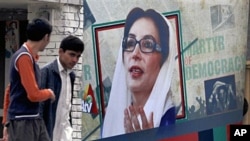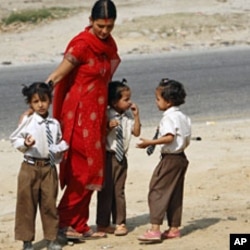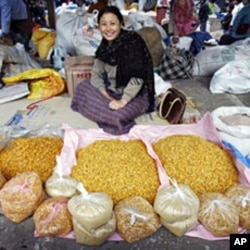South Asian women lag behind men in literacy, workforce participation, reproductive rights and most other areas. Yet the region’s array of female leaders put the rest of the world to shame.
With the exception of Nepal, Bhutan and Iran, Cornell University's Kathryn March, Feminist and Professor of Anthropology, Gender, Sexuality Studies and Public Affairs says, "Every single country there has had its highest political position occupied by a woman, at least once.”
March suggests the success of women leaders in India, Pakistan and other South Asian countries may be related to their family lineage.
Gender Indicators in South Asia
Shikha Bhatnagar, Associate Director of the South Asia Center at the Atlantic Council agrees, saying leaders like the late Pakistani politician, Benazir Bhutto, former Indian prime minister, Indira Ghandi, and the prime minister of Bangladesh, Sheikh Hasina, are all connected to powerful men and powerful families, which may have helped push them to leadership roles.
India, the world's largest democracy and a globalization hub, trails many of its South Asian neighboring in women's political representation, literacy and labor participation. Amna Tariq Shah, an English Literature and linguistics student at Peshawar University, sees similar extremes in neighboring Pakistan.
"We have had the first female Muslim prime minister [Bhutto]; the president of our Supreme Court Bar Council is a woman, and so is our speaker of the National Assembly," said Shah in an e-mail interview. "But on the other hand we have women who are confined to the four walls of their homes by their men.”
The price of marriage
Brandeis University's Harleen Singh, Professor of South Asian Literature, and Women and Gender Studies, says part of the problem is that South Asia women symbolize both a cherished culture and the fear of losing traditional patriarchal controls to modernization.
Take marriage, for example.
Amna Khalid Mahmoud, a Pakistani student studying in the U.S., says girls are usually allowed to study as long as their parents cannot find a suitable match for them. She says parents want to marry off their daughters at a young age - from 16-22 - in arranged marriages.
"And when she gets married, you're expected to offer a dowry to the family that the girl is getting married into ... Once she's married, she belongs to the other family, said Shikha Bhatnagar. "So that's not a long-term investment, where[as] a boy or son is expected to take care of his parents throughout his life."
Investing in sons
This contributes to a preference for sons. Cornel University's Kathryn March says South Asia’s equity and opportunity indicators are "very dismal," including what she calls India's "statistically-impossible sex ratios."
March says the 2011 census reports that there are 914 females for every 1,000 males in India today, down from 972 in 1901.
Despite strict laws banning infanticide, Singh says the deeply ingrained preference for male children in South Asian culture cuts across urban, rural, class, and literacy divides, thriving in patriarchal societies and in communities where old thinking prevails.
“And as long as they are bound by tradition and are dependent on their families and their husbands and the other ... patriarchal connections in their life, they will not have the will to be able to choose, or the means to be able to choose what they would want in terms of children or daughters."
Education, education, education
The Atlantic Council’s Bhatnagar echoes Singh, saying that female and sex selective abortion will decline as more women get access to health facilities and education, and as information seeps into remote and rural areas in India, Pakistan and Afghanistan, where there is an acute shortage of female teachers, schools, and facilities to support a female school body.
Bhatnagar suggests creating incentives to encourage teachers to work in rural areas and building more schools, particularly in rural areas in countries like Afghanistan, where girls have to walk very far to get to school.
But as modernization catches up with rural areas, women are becoming more aware of the value of educating their daughters, writes Mahjabeen Alam Baloch in an e-mail interview from Hyderabad, Pakistan.
With education, more women are branching away from their traditional jobs as garment workers in Bangladesh, brick workers in Pakistan, and farmers in India. Even with new fields opening to them, student Amna Mahmoud says most families still don't allow a woman to work, except in female-dominated fields like teaching and health care.
Breaking through the glass ceiling
But urban, middle-class working women are becoming more visible in South Asia, as rapid modernization changes the work place, traditionally built around an all-male workforce. Singh says middle-class men and women now share integrated work spaces in places like urban call centers and multinational ventures.
And it is there that women are caught between tradition and modernity.
"Women can still be tradition-bound to ask for their parents' permission in when and where they can go out, if it is not for work, and they are still beholden to pressures from their parents about whom they can marry, or not, and when," said Singh.
A young woman like Nausheen Rooh-Afroz, a recent Dhaka University graduate, lives with her parents in Bangladesh and has to abide by their rules. She majored in International Relations, but works as a contract employee dealing with migrant workers.
"Here, job opportunities for woman are very limited even [if] they are highly educated," said Shahidanaz Huda in an e-mail interview from Bangladesh. "But I am hopeful. The scenario is changing slowly as more woman come to [different] fields."
Huda, an accounts officer at the University of Dhaka, says female accounts officer were unheard of a few years ago. Now, she says, women are becoming more vocal in demanding their rights.
Microfinance
And as more women enter the workforce and earn a paycheck, they gain more leverage in families where husbands often make the important decisions. And they've been getting a lot of help from a tool that is more prevalent in South Asia than anywhere else in the world -microfinance.
"The traditional model, which was made famous by Grameen Bank in Bangladesh, gathers together groups of five women - and it is almost always women - who agree to be responsible for each others' loans," explained David Roodman, a senior fellow with the Center for Global Development. "And they take out small loans - they might take out $50 or a $100 - and they make weekly payments over the course of six months or a year. And there is no collateral like most lending in rich countries."
The downside is that a woman who is unable to pay off her loan comes under peer pressure so that others don't have to pay it off instead. In that sense, Roodman says microcredit can limit a woman's freedom. But it also empowers women by virtue of the fact that the loan will only be extended to her.
"It was a bit revolutionary because it drew women into a public space from which they were normally prohibited from entering," said Roodman. "Traditionally, there's something called purdah, which prohibits women from going to public spaces ... And this has provided them a kind of leverage ... So it's changing the rules a little bit.”
The rules are definitely changing. But only through education, economic development and inspiration from leaders like Indira Ghandi and Benazir Bhutto can the region’s women prove not only that they are as good an investment as men, but that they too can walk the path to power.


